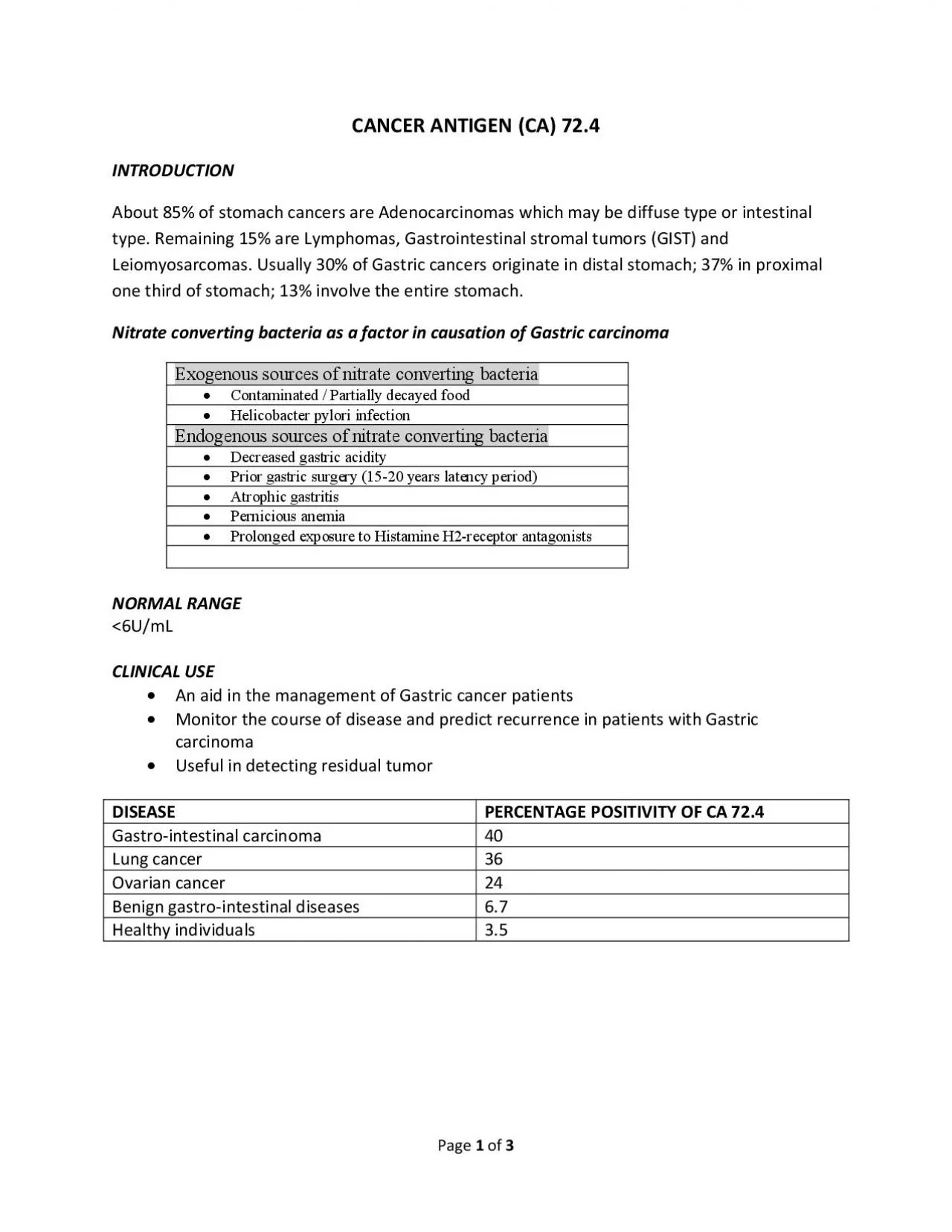

Page 1 of 3 CA 724 INTRODUCTION About 85 of stomach cancers are Adenocarcinomas which may be diffuse type or intestinal type Remaining 15 are Lymphomas Gastrointestinal stromal tumors GIST a ID: 938641
Download Pdf The PPT/PDF document "CANCER ANTIGEN" is the property of its rightful owner. Permission is granted to download and print the materials on this web site for personal, non-commercial use only, and to display it on your personal computer provided you do not modify the materials and that you retain all copyright notices contained in the materials. By downloading content from our website, you accept the terms of this agreement.
Page 1 of 3 CANCER ANTIGEN CA 72.4 INTRODUCTION About 85% of stomach cancers are Adenocarcinomas which may be diffuse type or intestinal type. Remaining 15% are Lymphomas, Gastrointestinal stromal tumors (GIST) and Leiomyosarcomas. Usually 30% of Gastric cancers originate in distal stomach; 37% in proximal one third of stomach; 13% involve the entire stomach. Nitrate converting bacteria as a factor in causation of Gastric carcinoma NORMAL RANGE U/mL CLINICAL USE An aid in the management of Gastric cancer patients Monitor the course of disease and predict recurrence in patients with Gastric carcinoma Useful in detecting residual tumor DISEASE PERCENTAGE POSITIVITY OF CA 72.4 Gastro - intestinal carcinoma 40 Lung cancer 36 Ovarian cancer 24 Benign gastro - intestinal diseases 6.7 Healthy individuals 3.5 Exogenous sources of nitrate converting bacteria Contaminated / Partially decayed food Helicobacter pylori inf
ection E nd ogenous sources of nitrate converting bacteria Decreased gastric acidity Prior gastric surgery (15 - 20 years latency period) Atrophic gastritis Pernicious anemia Prolonged exposure to H istamine H 2 - receptor antagonists Page 2 of 3 INTERPRETATION Increased Levels Gastric carcinoma Ovarian carcinoma Benign diseases Pancreatitis, Cirrhosis, Pulmonary disease, Rheumatic conditions, Ovarian cysts, Benign breast disease, Benign gastro - intestinal disorders HIGH RISK FACTORS FOR GASTRIC CANCER Helicobacter pylori infection Long term ingestion of nitrates in high levels a s in dried, smoked and salted foods Gastric ulcers Adenomatous polyps Menetrier’s disease Individuals with blood group A Germ line mutation in E - Cadherin gene (CDH1⤀ EARLY DETECTION OF GASTRIC CANCER Detection of Germ line mutation in E - Cadherin gene ⠀CD H1) in young asymptomatic carriers has been linked to
a high incidence of occult diffuse type gastric cancer Detection of KRAS mutations is indicative of early event in intestinal type Gastric cancer Cyclin E overexpression correlates with progression from dysplasia LABORATORY DIAGNOSIS Double contrast radiographic examination Gastroscopic biopsy and brush cytology Serum CA72.4 LIMITATIONS Sensitivity of monitoring Gastric carcinoma improves by combining CA 72.4 with CEA and CA 19.9 assays. False negative / positive results are observed in patients receiving mouse monoclonal antibodies for diagnosis or therapy This assay, regardless of level, should not be interpreted as absolute evidence for the presence or absence of malignant disease. Page 3 of 3 The assa y value should be used in conjunction with findings from clinical evaluation and other radiographic diagnostic procedures. Patients receiving Biotin therapy in high doses should not be tested for at least 8 hours after the last dos